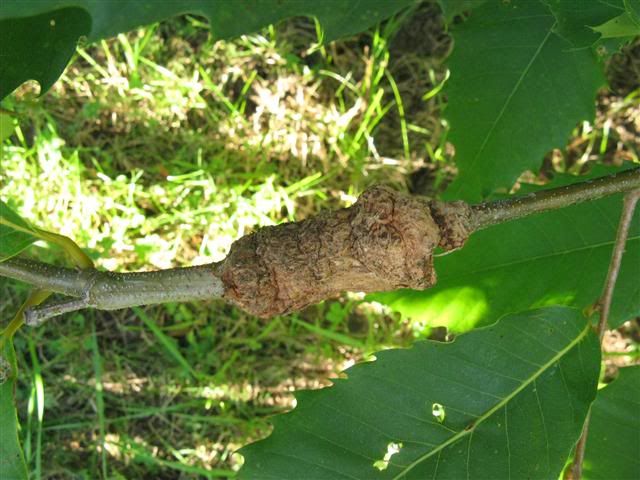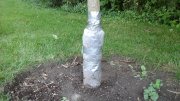My daughter and her friends were playing and accidently stripped away bark (2 inches all the way around) our ten year old weeping cherry tree. We re-attached the bark loosely with tape. Can this beloved tree be saved? Please advise!!!:msp_scared:
You are using an out of date browser. It may not display this or other websites correctly.
You should upgrade or use an alternative browser.
You should upgrade or use an alternative browser.
HELP! How to save a tree that was accidently girdled???
- Thread starter batfam
- Start date

Help Support Arborist Forum:
This site may earn a commission from merchant affiliate
links, including eBay, Amazon, and others.
There is not much hope, if you truly girdled the tree full circle. That being said, I think you might save the tree if you are quick and dedicated.
1. Carefully prune off all the damaged bark using a razor knife. It is providing no protection for the tree. Trim back to where the bark is still firmly attached to the trunk, without removing any bark that is still attached firmly.
2. Get some peat moss, duct tape, and some plastic sheeting. Heavy duty trash bags should work fine.
3. Seal the bottom of the injury all the way around with duct tape holding a circle of plastic. Layer a band about 2 inches thick in peat moss, right up against the injured area. When you are sure that the injury is completely covered with peat moss, seal it at the top with duct tape. Add several layers of plastic to be sure that there is a good moisture barrier.
4. Check it frequently for damage to the plastic, and change the bandage about once per year, preferably in the spring before the sap is rising.
5. Keep this up until the tree has formed a callous that completely covers the old injury with repair tissue, and the tree is not girdled anymore. This will probably take several years.
If you are incredibly lucky, your tree will continue to survive until the roots run out of energy to keep pumping nutrients back up the tree. The girdled area carries sap and sugars back down from the tree to the roots, so maintaining the flow of juices down to the roots is what is important here. If you provide a moisture retaining bandage until the tree can repair the injury, it might work.
For all you guys that are going to tell me that this is a crazy notion, I would agree with you until I watched a construction contractor keep a 14" diameter oak tree alive for two whole years. I had completely stripped the bark off of the tree for a band of bark at least 10 inches wide. Absolutely no bark on the tree where my 3/8" amsteel rope had girdled the tree, I completely abandoned hope for the tree. Instead, he wrapped it up real good, and it continued to live. I checked it a few months later, and the peat moss was spongy wet in the middle of summer, while the tree still looked pretty healthy.
The last time I checked it, it wasn't looking too good. The homeowner had not kept the bandage in good condition, and there were tears in the plastic and the peat moss was falling out.
It is unlikely that your tree is injured as bad as the one I described, so your chances of success are much better.
1. Carefully prune off all the damaged bark using a razor knife. It is providing no protection for the tree. Trim back to where the bark is still firmly attached to the trunk, without removing any bark that is still attached firmly.
2. Get some peat moss, duct tape, and some plastic sheeting. Heavy duty trash bags should work fine.
3. Seal the bottom of the injury all the way around with duct tape holding a circle of plastic. Layer a band about 2 inches thick in peat moss, right up against the injured area. When you are sure that the injury is completely covered with peat moss, seal it at the top with duct tape. Add several layers of plastic to be sure that there is a good moisture barrier.
4. Check it frequently for damage to the plastic, and change the bandage about once per year, preferably in the spring before the sap is rising.
5. Keep this up until the tree has formed a callous that completely covers the old injury with repair tissue, and the tree is not girdled anymore. This will probably take several years.
If you are incredibly lucky, your tree will continue to survive until the roots run out of energy to keep pumping nutrients back up the tree. The girdled area carries sap and sugars back down from the tree to the roots, so maintaining the flow of juices down to the roots is what is important here. If you provide a moisture retaining bandage until the tree can repair the injury, it might work.
For all you guys that are going to tell me that this is a crazy notion, I would agree with you until I watched a construction contractor keep a 14" diameter oak tree alive for two whole years. I had completely stripped the bark off of the tree for a band of bark at least 10 inches wide. Absolutely no bark on the tree where my 3/8" amsteel rope had girdled the tree, I completely abandoned hope for the tree. Instead, he wrapped it up real good, and it continued to live. I checked it a few months later, and the peat moss was spongy wet in the middle of summer, while the tree still looked pretty healthy.
The last time I checked it, it wasn't looking too good. The homeowner had not kept the bandage in good condition, and there were tears in the plastic and the peat moss was falling out.
It is unlikely that your tree is injured as bad as the one I described, so your chances of success are much better.
Kottonwood
ArboristSite Operative
yep, gotta keep the tree as healthy as possible as well, water it properly, keep the soil from being compacted, mulch around the base out to the dripline if it isn't done already. There are orchards that girdle trees to produce better fruit.... don't know how well it works. But if the wound is small your tree is likely to survive.
Remember girdling cuts off the flow to the roots not from the roots. If it is not recently planted it should have enough energy in the roots for it to last a couple of years, as long as the wound is starting to seal by then you should be good. You can use compost and very low grade organic fertilizers with many nutrients but do not fertilize with conventional npk fertilizer. This will just cause the tree to use up it's sugar reserves and die the next year.
There may be some dieback, I suggest to only prune off deadwood and do it during winter when the tree and most pests are dormant. A stressed tree like that is likely to attract pests, you should definitely keep an eye out for any common local pests (probably should talk to a local arb on that) and take action as soon as signs arise.
Remember girdling cuts off the flow to the roots not from the roots. If it is not recently planted it should have enough energy in the roots for it to last a couple of years, as long as the wound is starting to seal by then you should be good. You can use compost and very low grade organic fertilizers with many nutrients but do not fertilize with conventional npk fertilizer. This will just cause the tree to use up it's sugar reserves and die the next year.
There may be some dieback, I suggest to only prune off deadwood and do it during winter when the tree and most pests are dormant. A stressed tree like that is likely to attract pests, you should definitely keep an eye out for any common local pests (probably should talk to a local arb on that) and take action as soon as signs arise.
Last edited:
ch woodchuck
ArboristSite Operative
We re-attached the bark loosely with tape.
Use tape such as duct tape to secure the bark to the tree. Make sure that the bark is going in the right direction (the same direction it was on before it came off the tree as the phloem layer can only transport nutrients in one direction. Shouldn't be a problem...Doesn't take very long to reattach.We've done it several times successfully.Maybe keep the area covered as per our conrades suggested....No!I am not a commie...
Use tape such as duct tape to secure the bark to the tree. Make sure that the bark is going in the right direction (the same direction it was on before it came off the tree as the phloem layer can only transport nutrients in one direction. Shouldn't be a problem...Doesn't take very long to reattach.We've done it several times successfully.Maybe keep the area covered as per our conrades suggested....No!I am not a commie...

This is a very interesting suggestion by pdqdl: when the very same technique is applied to very small branches it is called air layering. In that case the girdling is intentional and the purpose is to encourage the branch tip above the wound to form roots. Once rooted, the branch is cut free and planted to produce a perfect clone of the parent tree.
As for the rate of callus formation, it can be very fast. The photo shows a failed air-layering experiment of mine on American chestnut. The thick callus formed in just one month and bridges a 2-inch gap where all the bark had been removed. Unfortunately, no roots formed.

For repairing a girdled tree the formation of callus is just the first necessary step. New cambium tissue must then form within the callus to restore proper vascular function to the barkless area. Since you have to bridge a very large gap, you can give the tree a big boost by installing several bridge grafts that vertically span the wounded area. The individual bridging scions already have perfectly functional vascular tissue and cambium and can unite with the parent tree across very small gaps at the upper and lower borders of the wound. You can find plenty on this technique on the Web, but here's one link that describes it.
I saw a tree that had been saved by this method years after the repair: it looked like the tree was standing on several stout pillars. Definitely a conversation piece.
As for the rate of callus formation, it can be very fast. The photo shows a failed air-layering experiment of mine on American chestnut. The thick callus formed in just one month and bridges a 2-inch gap where all the bark had been removed. Unfortunately, no roots formed.

For repairing a girdled tree the formation of callus is just the first necessary step. New cambium tissue must then form within the callus to restore proper vascular function to the barkless area. Since you have to bridge a very large gap, you can give the tree a big boost by installing several bridge grafts that vertically span the wounded area. The individual bridging scions already have perfectly functional vascular tissue and cambium and can unite with the parent tree across very small gaps at the upper and lower borders of the wound. You can find plenty on this technique on the Web, but here's one link that describes it.
I saw a tree that had been saved by this method years after the repair: it looked like the tree was standing on several stout pillars. Definitely a conversation piece.
2treeornot2tree
Dont cry, just do it
Just got to ask. how the heck do you accidently strip a 2" ring of bark of a tree?
landscape doc
ArboristSite Lurker
Bridge grafting is used on fruit trees when mice girdle trees over the winter. They eat all the bark around the tree and they can be saved and made to last many years although the bridged branches above and below the cambium break can look strange.
bluegirl
New Member
Found my poor beauty completely girdled with 1/2"x5" strips of

 bark on the ground below. The damage is approximately 8-12" of the trunk. The trunk is about 6" diameter. I have applied the peat moss bandage as described but should I also add repair grafting? Also should I wet the peat moss or allow the tree to equilibrate itself. We would really like to save this tree and also find a way to get rid of a few rebel critters. Here are pictures.
bark on the ground below. The damage is approximately 8-12" of the trunk. The trunk is about 6" diameter. I have applied the peat moss bandage as described but should I also add repair grafting? Also should I wet the peat moss or allow the tree to equilibrate itself. We would really like to save this tree and also find a way to get rid of a few rebel critters. Here are pictures.

 bark on the ground below. The damage is approximately 8-12" of the trunk. The trunk is about 6" diameter. I have applied the peat moss bandage as described but should I also add repair grafting? Also should I wet the peat moss or allow the tree to equilibrate itself. We would really like to save this tree and also find a way to get rid of a few rebel critters. Here are pictures.
bark on the ground below. The damage is approximately 8-12" of the trunk. The trunk is about 6" diameter. I have applied the peat moss bandage as described but should I also add repair grafting? Also should I wet the peat moss or allow the tree to equilibrate itself. We would really like to save this tree and also find a way to get rid of a few rebel critters. Here are pictures.Wayne68
ArboristSite Operative
Would the peat moss bandage technique work on a very large ash tree? We purchased a property where they had attached their clothesline to the tree with a chain and the chain has become embedded in the bark. The tree is trying very hard below this point to grow ie new shoots coming out the side. Please advise we would really like to save this beauty.
Jim Timber
1/4 bubble off
Would the peat moss bandage technique work on a very large ash tree? We purchased a property where they had attached their clothesline to the tree with a chain and the chain has become embedded in the bark. The tree is trying very hard below this point to grow ie new shoots coming out the side. Please advise we would really like to save this beauty.
I'd get the chain cut first. If it's grown-in already and can't be extracted without removing bark, then cut it in several places (vertically cut the links with a cut-off grinding disk - they can be bought at Home Depot or the like) so the chain doesn't continue to produce resistance to the outward growth of the tree. Small vertical cuts won't harm the tree, but only cut every 8" or more so you don't cause the same effect as the girdling in the beginning of this thread. Don't cut horizontally, and don't remove the chain if it's held in the bark. The tree will continue to grow around the links, but without the constriction.
Similar threads
- Replies
- 19
- Views
- 2K



